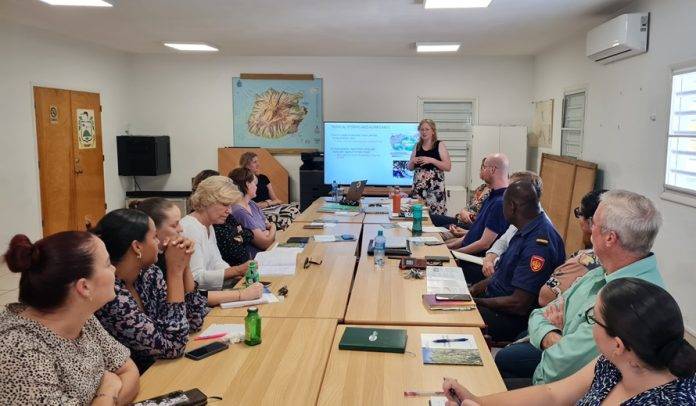Last week, climate scientists Iris Keizer and Nadia Bloemendaal of the Royal Netherlands Meteorological Institute (KNMI) visited Saba to share their knowledge on climate change. Their visit was in relation to the climate scenarios report that KNMI published last year in October. For the first time, the islands of Bonaire, St. Eustatius and Saba were included in this report, which forecasted possible future climate scenarios for the BES in relation to climate change.
Climate scenarios for Saba
In its report, KNMI focused on the implications of changes in temperature, precipitation, wind and sea-level for the BES islands. They also looked at how hurricanes will change in the future. KNMI developed 4 climate scenarios based on a future with high carbon dioxide emissions and a future with low carbon dioxide emissions. Carbon dioxide is one of the main drivers of global warming and climate change. Within the high and low emission scenarios, KNMI distinguished a wet and dry scenario, showing the results of extremes in development of precipitation.
In all 4 scenarios, the temperature and wind speed increase, while precipitation decreases. According to the models, the future climate of Saba will be more similar to that under El Niño conditions with less precipitation and higher wind speeds. This means that in the future it is possible that residents of Saba will experience warmer temperatures with the occurrence of more intense heatwaves, longer dry periods and stronger wind in general. However, while the models show an El Niño trend, climate observations show that the current climate is more similar to La Niña conditions, which bring more rain but are also more favorable for the development of hurricanes.
The report also shows that hurricanes may become stronger in the future as ocean temperatures increase. Simulation models reveal that the most severe hurricanes in the future will have higher maximum wind speeds and higher maximum precipitation intensities, although it is not clear whether hurricanes will occur more frequently. This means Saba residents may experience hurricanes with stronger wind speeds and more rainfall. Hurricanes may also intensify more rapidly in the future, jumping from a category 1 to a category 4 and higher in a short period of time. This is caused by warmer ocean temperatures, which act as a super fuel to feed hurricanes.
Saba will also experience sea-level rise. While this may not have an immediate effect on the island (with the exception of the harbor), it may impact surrounding islands and the US mainland from which Saba imports its food and other supplies.
Local (climate) stakeholders
Part of Keizer and Bloemendaal’s visit to Saba was to also get to know their stakeholders in the Caribbean part of the Netherlands and to understand the experiences of persons whose lives, in one way or another, have been impacted by extreme weather events as a result of climate change. They met with various stakeholders while on the island. One of their meetings was with various government department heads, policy advisors, and stakeholders in public safety and order, nature conservation and energy. As part of their research, it is important for Keizer and Bloemendaal to understand how climate change impacts the various government departments and sectors on the island. A townhall was also held for Keizer and Bloemendaal to share their knowledge with the general public and for them to hear the experiences of residents who have been impacted by climate change.
Keizer and Bloemendaal also met with and presented their climate research to the Executive Council. The goal of this meeting was to inform the island decision-makers on what can be expected in the future. This information is critical for deciding how to further development Saba with climate change in mind.
Preparing Saba for the future
While Saba contributes little to climate change (on a global scale), it and other islands in the region will feel the impacts of the climate change the most. The severity of the impacts of climate change are determined by the level of global carbon dioxide emissions and whether large, industrialized nations commit to policies and (international) agreements aimed at reducing emissions. This is something Saba does not have control over. Saba does, however, have control over how it can prepare and adapt to climate change.
Earlier this year, a climate agenda was developed with the Ministry of Economic Affairs and Climate Policy, the Ministry of Infrastructure and Water Management, the Ministry of Interior and Kingdom Relations together with the governments of the 6 Dutch Caribbean Island. The agenda has 8 priorities, which include increasing renewable energy, developing climate-resilient infrastructure and spatial planning, improving water and waste management, stimulating circular economies, intensifying ecosystem protection, financing and economic incentives, collaborative partnerships and knowledge sharing and monitoring and evaluation.
From this agenda, the Public Entity will make a climate plan with actions to prepare Saba for the future. During his speech at the townhall on climate change, Governor Jonathan Johnson stated, “Amidst these challenges lies an opportunity for us to chart a course towards a more resilient and sustainable future.” The aim is to complete the plan by the end of this year.































